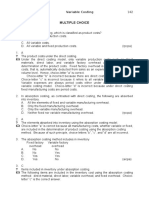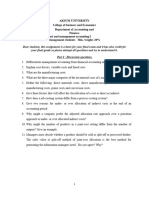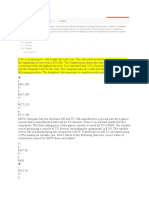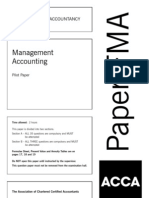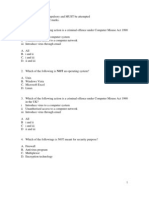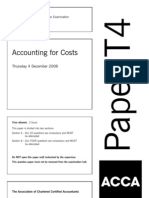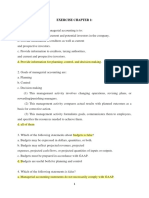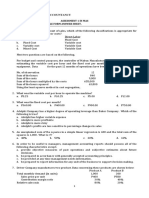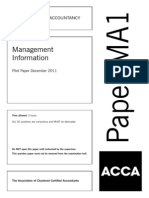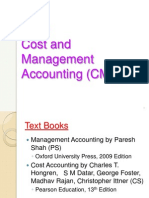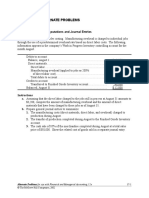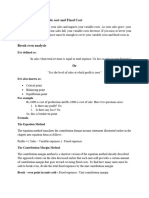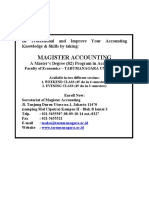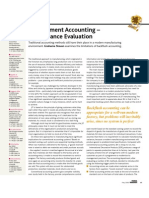0 ratings0% found this document useful (0 votes)
1 viewsSeries 1
Series 1
Uploaded by
Mouh CeneCopyright:
© All Rights Reserved
Available Formats
Download as PDF, TXT or read online from Scribd
Series 1
Series 1
Uploaded by
Mouh Cene0 ratings0% found this document useful (0 votes)
1 views3 pagesCopyright
© © All Rights Reserved
Available Formats
PDF, TXT or read online from Scribd
Share this document
Did you find this document useful?
Is this content inappropriate?
Copyright:
© All Rights Reserved
Available Formats
Download as PDF, TXT or read online from Scribd
Download as pdf or txt
0 ratings0% found this document useful (0 votes)
1 views3 pagesSeries 1
Series 1
Uploaded by
Mouh CeneCopyright:
© All Rights Reserved
Available Formats
Download as PDF, TXT or read online from Scribd
Download as pdf or txt
You are on page 1of 3
University of Algiers 3, The Faculty of Economics, Business and Management Sciences
Bachelor 2nd Grade, Business Administration
Management Accounting series of exercises, Pf Sami HAREK
Series 01: An introduction to cost terms and concepts
Question 1: Which of the following would be classed as indirect labour?
(A) assembly workers in a company manufacturing televisions
(B) a stores assistant in a factory store
(C) plasterers in a construction company
(D) an audit clerk in a firm of auditors
Question 2: Which one of the following would be classified as indirect labour?
(A) Assembly workers on a car production line
(B) Bricklayers in a house building company
(C) Machinists in a factory producing clothes
(D) Forklift truck drivers in the stores of an engineering company
Question 3: Fixed costs are conventionally deemed to be:
(A) constant per unit of output
(B) constant in total when production volume changes
(C) outside the control of management
(D) those unaffected by inflation
Question 4: If actual output is lower than budgeted output, which of the following costs would you
expect to be lower than the original budget?
(A) total variable costs (B) total fixed costs (C) variable costs per unit (D) fixed costs per unit
Question 5
(i) Costs may be classified in a number of ways including classification by behaviour, by function, by
expense type, by controllability and by relevance.
(ii) Management accounting should assist in EACH of the planning, control and decision-making processes
in an organization.
Discuss the ways in which relationships between statements (i) and (ii) are relevant in the design of an
effective management accounting system.
Question 6
(a) ‘Discretionary costs are troublesome because managers usually find it difficult to separate and quantify
the results of their use in the business, as compared with variable and other fixed costs.’
You are required to discuss the above statement and include in your answer the meaning of
discretionary costs, variable costs and fixed costs; give two illustrations of each of these three named
costs.
(b) A drug company has initiated a research project which is intended to develop a new product.
Expenditures to date on this particular research total £500,000 but it is now estimated that a further £200,000
1/3
University of Algiers 3, The Faculty of Economics, Business and Management Sciences
Bachelor 2nd Grade, Business Administration
Management Accounting series of exercises, Pf Sami HAREK
will need to be spent before the product can be marketed. Over the estimated life of the product the profit
potential has a net present value of £350,000.
You are required to advise management whether they should continue or abandon the project.
Support your conclusion with a numerate statement and state what kind of cost the £500,000 is.
(c) Opportunity costs and notional costs are not recognized by financial accounting systems but need to be
considered in many decisions taken by management.
You are required to explain briefly the meanings of opportunity costs and notional costs; give two
examples of each to illustrate the meanings you have attached to them.
Question 7
(a) Distinguish between ‘opportunity cost’ and ‘out of pocket cost’ giving a numerical example of
each using your own figures to support your answer.
(b) Jason travels to work by train to his five-day-a-week job. Instead of buying daily tickets he finds it
cheaper to buy a quarterly season ticket which costs £188 for 13 weeks.
Debbie, an acquaintance, who also makes the same journey, suggests that they both travel in Jason’s car and
offers to give him £120 each quarter towards his car expenses. Except for weekend travelling and using it
for local college attendance near his home on three evenings each week to study for his CIMA examinations,
the car remains in Jason’s garage.
Jason estimates that using his car for work would involve him, each quarter, in the following expenses:
Depreciation (proportion of annual figure) 200 £
Petrol and oil 128 £
Tyres and miscellaneous 52 £
You are required to state whether Jason should accept Debbie’s offer and to draft a statement to show
clearly the monetary effect of your conclusion.
(c) A company with a financial year 1 September to 31 August prepared a sales budget which resulted in the
following cost structure:
% of sales
Direct materials 32
Direct wages 18
Production overhead:
variable 6
fixed 24
Administrative and selling costs:
variable 3
fixed 7
Profit 10
After ten weeks, however, it became obvious that the sales budget was too optimistic and it has now been
estimated that because of a reduction in sales volume, for the full year, sales will total £2,560,000, which is
only 80 per cent of the previously budgeted figure.
You are required to present a statement for management showing the amended sales and cost
structure in pounds and percentages, in a marginal costing format.
2/3
University of Algiers 3, The Faculty of Economics, Business and Management Sciences
Bachelor 2nd Grade, Business Administration
Management Accounting series of exercises, Pf Sami HAREK
Question 8
A short course was held recently to introduce non-financial executives to management accounting and
finance. On the opening day one delegate observed:
(1) ‘I have no trouble with the terminology – direct costs, also called variable costs, are the ones that are
controllable, whereas indirect costs or overheads, also called fixed costs, are uncontrollable.’
(2) Later the purposes of management accounting systems were described as exclusively directed towards
‘costing and management control’.
Required:
(a) Explain the terms used in statement (1) and indicate with reasons whether you agree with it. You
may use examples to illustrate the points you make.
(b) Discuss whether statement (2) satisfactorily describes the purposes of management accounting
systems.
Question 9
In recent decades, in both the UK and elsewhere in the world, banks and other financial services institutions
have experienced both growth and change. Changing regulations and increasing competition over a wider
product range have occurred. Advances in information technology and digitalization have created significant
challenges and opportunities for the sector.
Required:
Discuss the management accounting information which could be developed in such organizations. In
particular, point out the purposes for which information might be required, describe the type of
information which may be provided and the limitations of this information.
3/3
You might also like
- Chap 5 - Variable CostingDocument21 pagesChap 5 - Variable CostingWil G. Binuya Jr.86% (7)
- Saa Group Cat TT7 Mock 2011 PDFDocument16 pagesSaa Group Cat TT7 Mock 2011 PDFAngie NguyenNo ratings yet
- Chapter 1 Cost Accounting Information For Decision MakingDocument5 pagesChapter 1 Cost Accounting Information For Decision MakingLorren K GonzalesNo ratings yet
- The Cost of Doing Business Study, 2019 EditionFrom EverandThe Cost of Doing Business Study, 2019 EditionNo ratings yet
- ACT600 Chapter 3Document67 pagesACT600 Chapter 3Ali H. AyoubNo ratings yet
- Cost I Assignment 2023Document2 pagesCost I Assignment 2023danielnebeyat7No ratings yet
- Allama Iqbal Open University, Islamabad Warning: (Department of Commerce)Document9 pagesAllama Iqbal Open University, Islamabad Warning: (Department of Commerce)AR KhanNo ratings yet
- Mid Term 2ndDocument16 pagesMid Term 2ndMinh Thư Nguyễn ThịNo ratings yet
- F2 Mock 2Document12 pagesF2 Mock 2Areeba alyNo ratings yet
- Cat/fia (Ma2)Document12 pagesCat/fia (Ma2)theizzatirosli50% (2)
- F5 QuestionsDocument10 pagesF5 QuestionsDeanNo ratings yet
- Management Programme Term-End Examination: December, 2017 Ms-004: Accounting and Finance For ManagersDocument3 pagesManagement Programme Term-End Examination: December, 2017 Ms-004: Accounting and Finance For ManagersreliableplacementNo ratings yet
- Instructions: Cpa Review School of The PhilippinesDocument17 pagesInstructions: Cpa Review School of The PhilippinesCyn ThiaNo ratings yet
- Management Accounting Midterm ExamDocument9 pagesManagement Accounting Midterm ExamMarjun Segismundo Tugano IIINo ratings yet
- Fma Past Paper 3 (F2)Document24 pagesFma Past Paper 3 (F2)Shereka EllisNo ratings yet
- 08 QuestionsDocument8 pages08 Questionsw_sampathNo ratings yet
- T2 Mock Exam (Dec'08 Exam)Document12 pagesT2 Mock Exam (Dec'08 Exam)vasanthipuruNo ratings yet
- t4 2008 Dec QDocument8 pagest4 2008 Dec QShimera RamoutarNo ratings yet
- AY 201 2013 EXAMINATION: 1. This Paper Consists of 6 Pages (Excluding Cover Page)Document8 pagesAY 201 2013 EXAMINATION: 1. This Paper Consists of 6 Pages (Excluding Cover Page)Chew Hong KaiNo ratings yet
- HO9 - Decentralized and Segment Reporting, Quantitative Techniques, and Standard Costing PDFDocument7 pagesHO9 - Decentralized and Segment Reporting, Quantitative Techniques, and Standard Costing PDFPATRICIA PEREZNo ratings yet
- Acc 213 3e Q2Document6 pagesAcc 213 3e Q2Rogel Dolino67% (3)
- Financial Information For Management: Time Allowed 3 HoursDocument14 pagesFinancial Information For Management: Time Allowed 3 HoursAnousha DookheeNo ratings yet
- RVU CMA Work Sheet March 2019Document12 pagesRVU CMA Work Sheet March 2019Henok FikaduNo ratings yet
- Mid TermDocument7 pagesMid Termpdmallari12No ratings yet
- Accountancy Review Center (ARC) of The Philippines Inc.: Mockboard ExaminationDocument10 pagesAccountancy Review Center (ARC) of The Philippines Inc.: Mockboard ExaminationJudy TotoNo ratings yet
- CMA PART2 MOCK 2_230623_152830Document37 pagesCMA PART2 MOCK 2_230623_152830nehalandethNo ratings yet
- Food Costs Supervisory SalariesDocument11 pagesFood Costs Supervisory SalariesJames CrombezNo ratings yet
- 2nd Evaluation Exam Key FINALDocument7 pages2nd Evaluation Exam Key FINALChristian GeronimoNo ratings yet
- Costing Full Length 1 (SM) - May 24Document10 pagesCosting Full Length 1 (SM) - May 24Jyoti ManwaniNo ratings yet
- EXERCISECHAPTER1Document5 pagesEXERCISECHAPTER1Bạch ThanhNo ratings yet
- Final Exam, s2, 2017-FinalDocument16 pagesFinal Exam, s2, 2017-FinalShiv AchariNo ratings yet
- CMA-Consolidated MCQ and Short QuestionsDocument20 pagesCMA-Consolidated MCQ and Short QuestionsVikesh MojeedraNo ratings yet
- TestBank Chapter-1Document39 pagesTestBank Chapter-1BAHAA SALEHNo ratings yet
- Management AccountingDocument9 pagesManagement AccountingMarjun Segismundo Tugano IIINo ratings yet
- Pre FinalDocument8 pagesPre Finalpdmallari12No ratings yet
- CPAR B94 MAS Final PB Exam - QuestionsDocument13 pagesCPAR B94 MAS Final PB Exam - QuestionsSilver LilyNo ratings yet
- Management Advisory Services Second Pre-Board Examinations Multiple Choice: Shade The Box Corresponding To Your Answer On The Answer SheetDocument15 pagesManagement Advisory Services Second Pre-Board Examinations Multiple Choice: Shade The Box Corresponding To Your Answer On The Answer SheetRhad EstoqueNo ratings yet
- Fall 2008 Exam 3 BDocument5 pagesFall 2008 Exam 3 BNO NameNo ratings yet
- Tutorial 2Document5 pagesTutorial 2Hirushika BandaraNo ratings yet
- Cima C01 Samplequestions Mar2013Document28 pagesCima C01 Samplequestions Mar2013Abhiroop Roy100% (1)
- Mas AssessmentDocument7 pagesMas AssessmentLuna VNo ratings yet
- Nguyễn Bảo Ngọc - BAFNIU17016Document3 pagesNguyễn Bảo Ngọc - BAFNIU17016Thu ThuNo ratings yet
- Acp5efm13 J CombinedDocument36 pagesAcp5efm13 J CombinedHan HowNo ratings yet
- 3.5 ExercisesDocument13 pages3.5 ExercisesGeorgios MilitsisNo ratings yet
- Exam 21082011Document8 pagesExam 21082011Rabah ElmasriNo ratings yet
- Management AccountingDocument145 pagesManagement AccountingSaad kaleemNo ratings yet
- FINALDocument8 pagesFINALpdmallari12No ratings yet
- Level 1 Accounting & Finance in Business ECON1041WE01 2020Document16 pagesLevel 1 Accounting & Finance in Business ECON1041WE01 2020FiNo ratings yet
- Mock 1Document12 pagesMock 1Mohsena MunnaNo ratings yet
- Ma1 PilotDocument17 pagesMa1 PilotKu Farah Syarina0% (1)
- FREV Finman 1Document10 pagesFREV Finman 1Jay Ann DomeNo ratings yet
- Cup-Management Advisory ServicesDocument7 pagesCup-Management Advisory ServicesJerauld BucolNo ratings yet
- Assignment For First Sem CMDocument4 pagesAssignment For First Sem CMnishant khadkaNo ratings yet
- Advanced Cost and Management Acct MSC LeadstarDocument7 pagesAdvanced Cost and Management Acct MSC LeadstarKalkidan pm100% (1)
- Group & Individual AssignmentDocument4 pagesGroup & Individual AssignmentKinetibebNo ratings yet
- Wiley CMAexcel Learning System Exam Review 2017: Part 2, Financial Decision Making (1-year access)From EverandWiley CMAexcel Learning System Exam Review 2017: Part 2, Financial Decision Making (1-year access)No ratings yet
- Wiley CMAexcel Learning System Exam Review 2017: Part 1, Financial Reporting, Planning, Performance, and Control (1-year access)From EverandWiley CMAexcel Learning System Exam Review 2017: Part 1, Financial Reporting, Planning, Performance, and Control (1-year access)No ratings yet
- Beyond Earnings: Applying the HOLT CFROI and Economic Profit FrameworkFrom EverandBeyond Earnings: Applying the HOLT CFROI and Economic Profit FrameworkNo ratings yet
- A Comparative Analysis of Tax Administration in Asia and the Pacific: 2016 EditionFrom EverandA Comparative Analysis of Tax Administration in Asia and the Pacific: 2016 EditionNo ratings yet
- Blcok-5 MCO-7 Unit-4Document16 pagesBlcok-5 MCO-7 Unit-4Tushar SharmaNo ratings yet
- CMA Notes and ReviewerDocument10 pagesCMA Notes and ReviewerMarwin Ace KaiklianNo ratings yet
- Titles Are Automatically Indented When Amount Is Entered. Do Not Indent Manually.)Document3 pagesTitles Are Automatically Indented When Amount Is Entered. Do Not Indent Manually.)music niNo ratings yet
- Chapter 1 Cost IDocument31 pagesChapter 1 Cost IBikila MalasaNo ratings yet
- Cost and Management Accounting OverviewDocument40 pagesCost and Management Accounting OverviewpRiNcE DuDhAtRaNo ratings yet
- Chapter 1 - How MA Information Supports Decision MakingDocument11 pagesChapter 1 - How MA Information Supports Decision Makingtaiyo_hoshiNo ratings yet
- Chapter-1 Introduction To Cost and Management AccountingDocument14 pagesChapter-1 Introduction To Cost and Management AccountingJatin DhingraNo ratings yet
- Chapter 17 Alternate Problems Problem 17.1A: Alternate Problems For Use With Financial and Managerial Accounting, 12eDocument8 pagesChapter 17 Alternate Problems Problem 17.1A: Alternate Problems For Use With Financial and Managerial Accounting, 12eSharadPanchalNo ratings yet
- Target Cost AnswersDocument6 pagesTarget Cost Answerspaul sagudaNo ratings yet
- Cost Article ReviewDocument3 pagesCost Article ReviewKetema Asfaw100% (7)
- C.A-I Chapter-5Document4 pagesC.A-I Chapter-5Tariku KolchaNo ratings yet
- Chap005 UpdatedDocument35 pagesChap005 UpdatedRizki Aulia KusumawisantoNo ratings yet
- 2marks PDFDocument163 pages2marks PDFkarthikeyan01100% (1)
- 07 Quiz 1 - ARGDocument3 pages07 Quiz 1 - ARG•MUSIC MOOD•No ratings yet
- Margin of SafetyDocument25 pagesMargin of Safetyayesha baberNo ratings yet
- Standard Costing and Variances - Questions For CAF-08Document19 pagesStandard Costing and Variances - Questions For CAF-08fareha riazNo ratings yet
- 4 Lecture - CVP AnalysisDocument34 pages4 Lecture - CVP AnalysisDorothy Enid AguaNo ratings yet
- 05a AMP Basics Cost Accounting PricingDocument100 pages05a AMP Basics Cost Accounting PricingPriyanka VunnamNo ratings yet
- Solved Glavine Corporation Manufactures Precision Equipment Made To Order For TheDocument1 pageSolved Glavine Corporation Manufactures Precision Equipment Made To Order For TheDoreenNo ratings yet
- Cost Accounting Project TopicsDocument14 pagesCost Accounting Project TopicsSudha AgarwalNo ratings yet
- Cost Accounting Quiz 1 - Statement of Cost of Goods ManufacturedDocument4 pagesCost Accounting Quiz 1 - Statement of Cost of Goods ManufacturedMarkJoven BergantinNo ratings yet
- Value-Chain 029 SamarpreetDocument18 pagesValue-Chain 029 SamarpreetRattan Deep SInghNo ratings yet
- CH8 InventoriesDocument37 pagesCH8 InventoriesStudent Sokha ChanchesdaNo ratings yet
- Horngren: Accounting 6Document2 pagesHorngren: Accounting 6MIKASANo ratings yet
- Magister Accounting: Be Professional and Improve Your Accounting Knowledge & Skills by TakingDocument10 pagesMagister Accounting: Be Professional and Improve Your Accounting Knowledge & Skills by TakingMaskurNo ratings yet
- Factory Overhead BudgetDocument15 pagesFactory Overhead BudgetFuad Al-FadhilNo ratings yet
- Backflush Accounting FM May06 p43-44Document2 pagesBackflush Accounting FM May06 p43-44khengmaiNo ratings yet
- Bba Ii Year Assignment Question PapersDocument7 pagesBba Ii Year Assignment Question PapersAfrina ThasneemNo ratings yet
